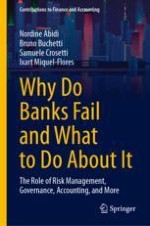2024 | OriginalPaper | Chapter
2. Risk Management and Banking Failures
Authors : Nordine Abidi, Bruno Buchetti, Samuele Crosetti, Ixart Miquel-Flores
Published in: Why Do Banks Fail and What to Do About It
Publisher: Springer Nature Switzerland
Activate our intelligent search to find suitable subject content or patents.
Select sections of text to find matching patents with Artificial Intelligence. powered by
Select sections of text to find additional relevant content using AI-assisted search. powered by
